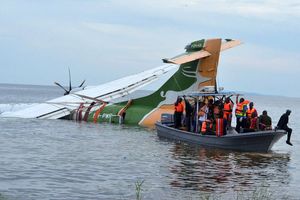Tanzania- Kenya at it yet again

Tanzania's foreign minister January Makamba and his Kenyan counterpart Musalia Mudavadi
What you need to know:
Kenya might not hit the panic button on Uganda, Rwanda, and other East African Community (EAC) countries, but it’s a different ball game when it comes to Tanzania.
On Monday, Tanzania announced it was suspending Kenya Airways (KQ) flights to its commercial capital Dar es Salaam from January 22 in response to Nairobi’s denial of Tanzania’s request for its carrier to make cargo flights to Kenya.
KQ operates 33 scheduled flights per week between Nairobi and Dar es Salaam, so that would be a big hit for a carrier that is already struggling.
As the letter announcing Tanzania’s decision spread rapidly on social media and WhatsApp, Kenya responded fast. Prime Cabinet Secretary and Foreign and Diaspora Affairs Minister Mr Musalia Mudavadi took to X (formerly Twitter) to announce that: “I have this evening spoken to H.E. @Jmakamba [January Makamba] (MP), Minister for Foreign Affairs and East African Cooperation of the United Republic of Tanzania, with regard to the decision of the Tanzania Civil Aviation Authority to rescind the approvals for @KenyaAirways to operate passenger flights between Nairobi and Dar es Salaam with effect from 22nd January 2024.
“We have jointly agreed that our respective Civil Aviation Authorities will work together to have the matter resolved amicably within the next three days”.
It was the quickest response by Nairobi to a diplomatic or geo-economic issue in recent years. It contrasted sharply with the response recently when a Cabinet secretary assailed Rwanda President Paul Kagame’s leadership, and in November when Uganda, complaining of predatory practices by middlemen, announced it would stop buying fuel products from Kenyan companies, and look to ship more of it through Dar es Salaam.
Uganda imports petroleum products worth $2 billion annually from Kenya, and the Kenya Pipeline Company (KPC) handles the bulk of it, earning up to $100 million a year.
Uganda was seeking to import its fuel products directly, but use KPC systems. Kenya all but told Uganda to go and jump into Lake Victoria, and senior Kenyan officials mocked it.
Frustrated, Uganda has now dragged Kenya to the East African Court of Justice (EACJ) over the issue.
Kenya might not hit the panic button on Uganda, Rwanda, and other East African Community (EAC) countries, but it’s a different ball game when it comes to Tanzania.
One of the reasons is that there is a lot of adversarial history between the two countries, starting from the late 1960s ideological rivalries. Tanzania slated Kenya as a rapacious, corrupt, man-eat-man society. Kenya hit back, knocking socialist Tanzania as a man-eat-nothing miserable economy.
There have always been political points to be won in Tanzania for being tough on Kenya. It has often led to some over-the-top actions. In 2017, the mercurial President John Magufuli’s government had 6,400 live chicks imported from Kenya burnt in a big bonfire.
President Samia Suluhu Hassan, who succeeded Magufuli following his death in March 2021, a year later acknowledged that the order to burn the Kenyan chicks imported was wrong.
However, at that time Suluhu was still a rookie president, still charming her way around in velvet gloves. Now more sure-footed, President Suluhu has cast away the gloves and worn the traditional brass knuckles with which her predecessors used to deal with Kenya.
Also, underlying recent Nairobi-Dodoma spats is an unspoken but serious race for regional hegemony. Right now Kenya is far out the leading East African economy, and regional financial hub. But it won’t be for much longer. In April 2023, the International Monetary Fund (IMF) projected that the Tanzanian economy would be larger than Kenya’s within the next decade (i.e. 2033). The Tanzanian press crowed about the report, and international media also played the story up. That bit of the report was largely ignored in the Kenyan media.
Kenya and Tanzania also position themselves differently geopolitically. Kenya plays regional power on two fronts – in the EAC, and in the Horn of Africa, institutionally in the Intergovernmental Authority on Development (IGAD). However, in the Horn of Africa, it has been stymied by Ethiopia, a larger economy and more muscular military power and, until its blow-up last year, Sudan.
Tanzania, on the other hand, plays on three fronts; in the EAC, in the Southern African Development Community (SADC) – with 16 members a bigger bloc than the EAC – and in Central Africa. Dodoma sees itself as a more sophisticated geopolitical actor than Nairobi.
Having deployed as part of SADC in Mozambique’s troubled Cabo Delgado province to combat Islamist rebels who had taken over the oil and mineral-rich region, it can claim some of the credit for pacifying the area and beating the rebels, although the Rwanda military intervention was the decisive factor in that fight.
The Tanzania military was the tip of the spear in the United Nations’ Force Intervention Brigade (FIB) in the eastern Democratic Republic of Congo in 2013, the most effective international deployment ever in the troubled region.
With South Africa half-failing, Zimbabwe in the dust, and previous giants like Angola in decline, these circumstances have combined to elevate Tanzania to incoming SADC big boy.
With its infrastructure boom in top flight and projecting into Central Africa, and an economy projected to post decent growth in 2024, Tanzania is beginning to feel like a regional prince – and acting like one.




